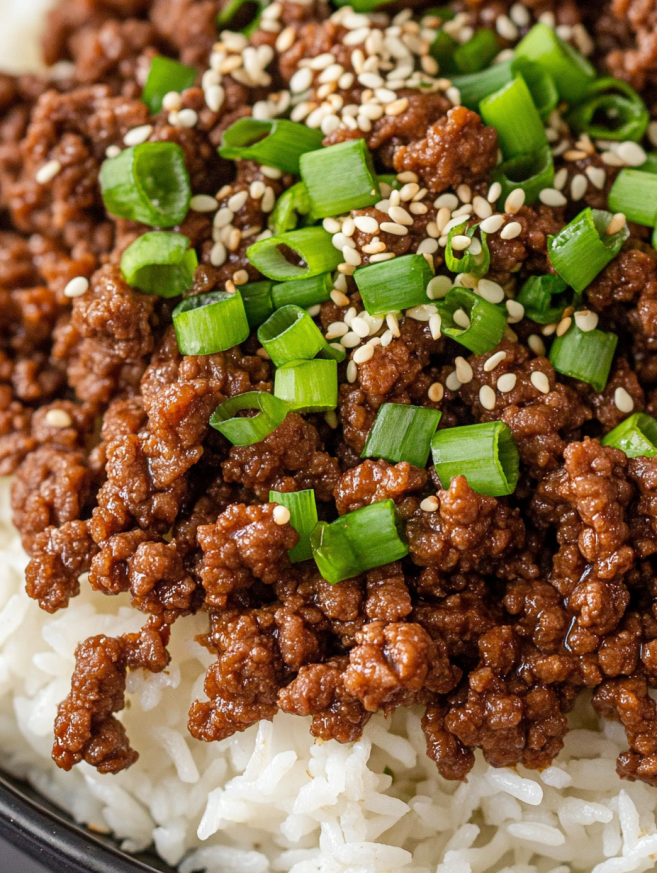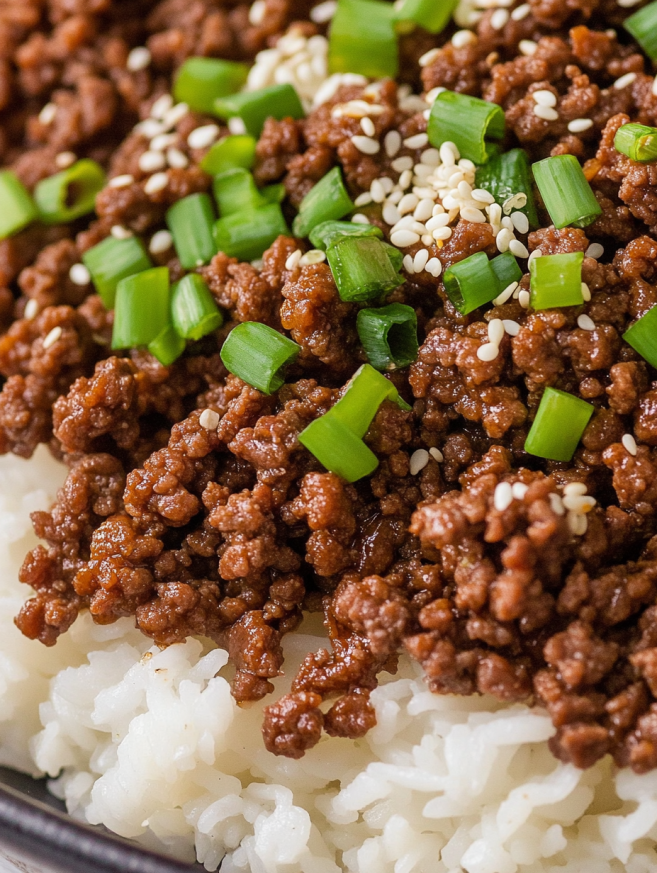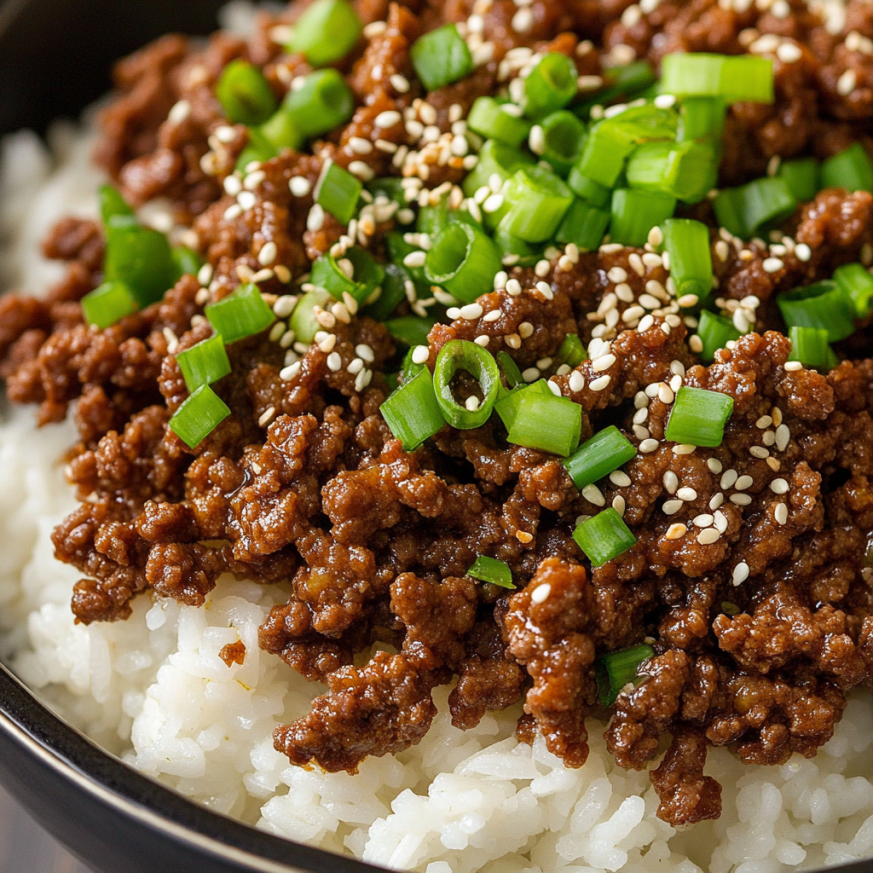Walking through the bustling streets of Seoul during my college exchange program, I discovered a tiny restaurant tucked between traditional shops where the aroma of sizzling beef and caramelized soy sauce filled the air. The owner, a kind elderly woman who spoke little English, served me my first authentic bulgogi – and I was absolutely hooked. Years later, as a busy parent juggling work and family, I craved those same incredible flavors but needed something much quicker than the traditional hours-long marinating process.
This ground beef version captures every bit of that authentic Korean magic while fitting perfectly into hectic weeknight schedules. By using readily available ground beef instead of expensive cuts, we create a dish that’s both budget-friendly and incredibly satisfying. The secret lies in building layers of flavor through proper cooking technique rather than lengthy marination.
Why This Recipe Will Transform Your Weeknight Dinners
Prep Time: 5 minutes
Cook Time: 10 minutes
Total Time: 15 minutes
Servings: 4
This Korean beef bowl deserves a permanent spot in your dinner rotation for several compelling reasons. First, the remarkable speed – in just 15 minutes, you’ll have a restaurant-quality meal that rivals any takeout option. Unlike traditional bulgogi that requires hours of advance planning, this version delivers complex flavors through smart cooking techniques.
Additionally, the ingredient list consists of pantry staples that most home cooks already have on hand. The combination of sweet brown sugar, savory soy sauce, and aromatic sesame oil creates a sauce that’s both familiar and exotic. Each bite offers that perfect balance of sweet, salty, and umami that makes Korean cuisine so addictive.
Perfect for Busy Families
Another significant advantage is the cost-effectiveness. While authentic bulgogi uses premium cuts like ribeye or sirloin, this recipe transforms affordable ground beef into something extraordinary. The technique of browning the meat properly before adding the sauce creates depth and complexity that you’d never expect from such an economical ingredient.
Essential Ingredients
Main Components
- 2 tablespoons brown sugar – Creates the signature sweet-savory Korean balance
- ¼ cup soy sauce – Choose regular or low-sodium based on your preference
- 1 teaspoon sesame oil – Absolutely essential for authentic Korean flavor
- 1 teaspoon Sriracha hot sauce – Adjust quantity to match your heat tolerance
- 1 pound ground beef – Lean varieties (90/10 or 96/4) work best
- 1 teaspoon fresh ginger, minced – Fresh ginger is crucial for bright flavor
- 1 tablespoon olive oil – For cooking the beef properly
- 2 cloves garlic, minced – Fresh garlic makes a noticeable difference
- 4 stalks green onions, thinly sliced – Save some for garnishing
- 1 tablespoon sesame seeds – Toast them for enhanced nutty flavor
- Salt and pepper to taste – For final seasoning adjustments
Ideal Serving Companions
- Steamed jasmine or short-grain rice
- Cauliflower rice for low-carb preferences
- Crispy Asian-style vegetables
- Pickled cucumber or radish
- Kimchi for authentic Korean experience
Step-by-Step Instructions
Preparing the Sauce Foundation
Start by whisking together the brown sugar, soy sauce, sesame oil, and Sriracha in a small bowl. Whisk thoroughly until the brown sugar completely dissolves, ensuring even sweetness distribution throughout the dish. This sauce mixture can be prepared up to a week in advance and stored in the refrigerator.
Mastering the Beef Cooking Technique
Heat olive oil in a large skillet over medium heat until it shimmers slightly. Add the ground beef, spreading it evenly across the pan’s surface. Here’s the crucial technique: resist stirring for the first 2-3 minutes. This allows the meat to develop a beautiful caramelized crust that adds incredible depth to the final dish.
Building Complex Flavors
After the initial browning period, break up the beef with a spatula and add the minced ginger and garlic. Cook for approximately 30 seconds until fragrant – you’ll smell the aromatics blooming. Pour in the prepared sauce mixture, which will create an appetizing sizzle as it hits the hot pan.
Stir everything together and continue cooking for 3-4 minutes, allowing the sauce to reduce and coat the beef beautifully. The mixture should develop a glossy appearance as the sugars caramelize and the flavors intensify.
Finishing Touches
Add the sliced green onions and cook for just 1-2 minutes more. You want them to soften slightly while maintaining their bright color and fresh bite. Remove the skillet from heat and immediately sprinkle sesame seeds over the top. Season with salt and pepper to taste, remembering that soy sauce already contributes significant saltiness.
Serving Suggestions
Traditional Korean Presentation
Serve this flavorful beef over steamed white rice with sides of kimchi and pickled vegetables. The combination creates an authentic Korean meal experience that balances the rich, sweet-savory beef with tangy, fermented accompaniments.
Health-Conscious Alternatives
For lighter options, serve the beef over cauliflower rice or spiralized vegetables. Add plenty of steamed broccoli, snap peas, or bok choy to create a complete, nutritious meal that doesn’t sacrifice any flavor.
Interactive Family Style
Create a build-your-own bowl station with various toppings: shredded carrots, cucumber slices, edamame, and roasted seaweed sheets. This approach makes dinner more engaging for children while accommodating different family preferences.

Creative Recipe Variations
Heat Enthusiast’s Version
Increase the Sriracha to your preferred level, or add fresh sliced jalapeños and red pepper flakes. For authentic Korean heat, substitute gochujang (Korean chili paste) for Sriracha – start with half the amount since it’s considerably more potent.
Vegetable-Enhanced Options
Incorporate colorful vegetables like bell peppers, mushrooms, or snap peas during cooking. Add harder vegetables like carrots early in the process, while tender ones like snow peas should go in during the final minutes to maintain their crunch.
Alternative Protein Choices
This recipe adapts beautifully to ground turkey, chicken, or plant-based meat alternatives. Adjust cooking times slightly for different proteins, ensuring everything reaches appropriate internal temperatures for food safety.
Reduced-Sodium Version
Use low-sodium soy sauce and compensate with extra ginger, garlic, and a splash of rice vinegar to maintain flavor complexity while reducing overall sodium content.
Make-Ahead Tips
Preparation Strategies
Although this recipe is already remarkably quick, you can prepare the sauce mixture up to a week ahead. Store it covered in the refrigerator and whisk before using. Pre-mincing ginger and garlic also saves valuable time during busy weeknights.
Meal Prep Excellence
This Korean beef reheats exceptionally well, making it ideal for weekly meal preparation. Cook double batches on weekends and portion into containers with rice and vegetables for convenient grab-and-go lunches throughout the week.
Freezing Guidelines
The cooked beef mixture freezes successfully for up to three months. Cool completely before transferring to freezer-safe containers, leaving space for expansion. Thaw overnight in the refrigerator and reheat gently on the stovetop with a splash of water if needed.
Storage Recommendations
Refrigerate leftovers for up to four days in covered containers. The flavors actually improve with time as the beef continues absorbing the sauce. Reheat gently to prevent the meat from becoming tough or dry.
Important Notes
The quality of your soy sauce significantly impacts the final flavor profile. While premium brands aren’t necessary, avoid overly salty or artificial-tasting varieties. Look for naturally brewed soy sauce for the most authentic results.
Never skip the sesame oil – it’s irreplaceable and provides the distinctive nutty flavor that makes this dish authentically Korean. Use it sparingly, as a little goes a long way, and too much can overwhelm the other carefully balanced flavors.
Ground beef continues cooking from residual heat even after removing from the stove. Therefore, slightly undercook initially, allowing the meat to finish cooking perfectly while adding final seasonings.
Using lean ground beef prevents the dish from becoming greasy, while proper browning creates better texture and prevents excess oil accumulation.

Frequently Asked Questions
How can I make this dish less sweet? Reduce the brown sugar to 1 tablespoon or omit it entirely for a more savory profile. You can also add a tablespoon of rice vinegar to balance any remaining sweetness with bright acidity.
What’s the proper way to toast sesame seeds? Heat a dry skillet over medium heat and add sesame seeds. Stir constantly for 2-3 minutes until golden brown and fragrant. Watch carefully to prevent burning. Toasted seeds provide superior nutty flavor and appealing crunch.
Can I substitute different hot sauces for Sriracha? Certainly, though the flavor will change. Gochujang offers the most authentic Korean heat, while sambal oelek provides similar spiciness without vinegar tang. Start with smaller amounts and adjust according to your heat preference.
How do I prevent the ground beef from becoming mushy? Use lean ground beef and avoid overcooking. The initial browning step creates essential texture. Don’t stir too frequently after adding the sauce, and remove from heat immediately when the beef reaches proper doneness.
Which vegetables work best as additions? Bell peppers, snap peas, mushrooms, and carrots all complement this dish beautifully. Add firmer vegetables like carrots early in cooking, while delicate ones like snap peas should go in during the final minutes to preserve their crunch.
Is this suitable for weekly meal prep? Absolutely! This Korean beef actually improves in flavor after the ingredients have time to meld together. Portion with rice and vegetables for convenient reheating. It maintains quality for up to four days refrigerated.
Nutritional Information (per serving):
- Calories: 245
- Carbohydrates: 9g
- Fat: 11g
- Protein: 26g
- Sodium: 720mg
- Fiber: 1g

